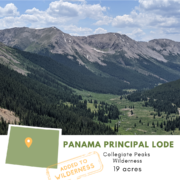Public access to Colorado’s Chicago Basin protected!
January 24, 2025-
For most visitors, the hike to Chicago Basin in Colorado’s Weminuche Wilderness starts on the historic Durango & Silverton Narrow Gauge Railroad as it winds 30 miles through the mountains. From the train stop, the Needle Creek Trail climbs steadily for 6 miles till the valley opens up into the sweeping views of Chicago Basin and the surrounding peaks. Due to its convenient access from the train and to its iconic 14,000+ ft peaks, the basin is a popular destination, with heavy use through the summer months for hikers, backpackers, and mountaineers.
Most of those visitors who come to Chicago Basin for the scenic beauty and quiet solitude of the wilderness are unaware that the trail they’re traversing crosses several privately owned inholding properties where that experience is not guaranteed. Without the protections of the surrounding wilderness, these properties could be developed with cabins, resorts, or mining and timber operations. Suddenly their wilderness experience could be dominated by the buzz of chainsaws, the thwomp of landing helicopters, or even the trail blocked and closed to the public. This lingering threat to public access, as well as the integrity of the fragile, high alpine ecosystem has driven our work in the Weminuche, along with wilderness areas across the county.
The Trust recently protected our 15th property in the Weminuche Wilderness with the acquisition of a 30-acre private inholding property with both Needle Creek and the Needle Creek Trail running through it. With flat, buildable stream-side sites the property was at risk of development. Now protected, public access on the trail to Chicago Basin has been ensured for future generations to enjoy. Needle Creek is an important tributary to the Animas River. This water source, along with vibrant aspen groves that stretch from the creek up the slopes of the Needle Mountains, create habit for a wide range of wildlife. The Needle Creek property scores high for climate change resilience, biodiversity, and landscape connectivity, all important conservation values that will be protected as wilderness.
Now that the property has been acquired by the Trust, we will begin restoration work this summer to remove the remnants of a hunting camp left by a previous owner to restore it to its wilderness character prior to transfer to public ownership and addition to the wilderness. This project builds off the nearby 7-acre Emerald Lake property that the Trust acquired in 2018 and transferred to be added to the wilderness area in 2023.




 This year we protected 42 properties totaling 2,073 acres from Alaska to Virginia. With the threat of development removed, they will remain open for wildlife to roam, resilient habitats to thrive, and people from all walks of life to explore. The monetary value of these lands is over $37 million, but the real value that they bring to our lives through clean air and water, solitude, and inspiration is so much greater. In this fast-changing world, their intrinsic value surpasses any dollar amount.
This year we protected 42 properties totaling 2,073 acres from Alaska to Virginia. With the threat of development removed, they will remain open for wildlife to roam, resilient habitats to thrive, and people from all walks of life to explore. The monetary value of these lands is over $37 million, but the real value that they bring to our lives through clean air and water, solitude, and inspiration is so much greater. In this fast-changing world, their intrinsic value surpasses any dollar amount.

 Brad- This holiday season, I am most thankful for our generous donors who provide the critical financial resources that we need in order to pursue our mission. They routinely welcome me into their homes or to sit down and share a meal, share their personal experiences that connect them to wilderness, and offer all that they can to support what we do. All of them are more than supporters of The Wilderness Land Trust. They are family and I remain forever grateful for their generosity.
Brad- This holiday season, I am most thankful for our generous donors who provide the critical financial resources that we need in order to pursue our mission. They routinely welcome me into their homes or to sit down and share a meal, share their personal experiences that connect them to wilderness, and offer all that they can to support what we do. All of them are more than supporters of The Wilderness Land Trust. They are family and I remain forever grateful for their generosity.














 After the Trust acquires a private property in or around wilderness, we work with our agency partners to assess whether any restoration work is needed prior to transferring it to public ownership. Our goal is to restore the property to its wilderness character, improve habitat, and mitigate any public safety concerns on the property. What exactly that restoration looks like is different for each property, and has ranged from removing cabins, vehicles, and commercial mining equipment, to closing historic mine adits, and packing out trash.
After the Trust acquires a private property in or around wilderness, we work with our agency partners to assess whether any restoration work is needed prior to transferring it to public ownership. Our goal is to restore the property to its wilderness character, improve habitat, and mitigate any public safety concerns on the property. What exactly that restoration looks like is different for each property, and has ranged from removing cabins, vehicles, and commercial mining equipment, to closing historic mine adits, and packing out trash.

